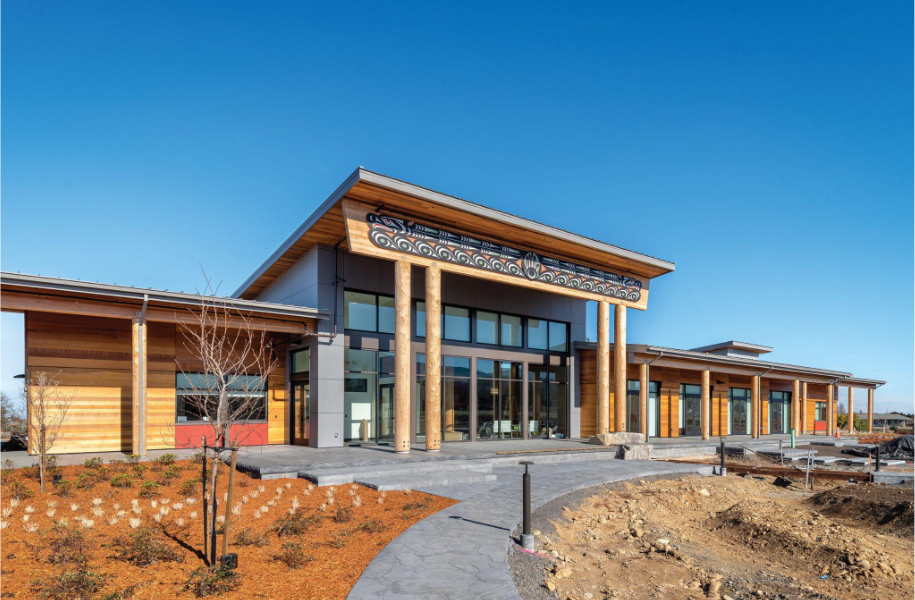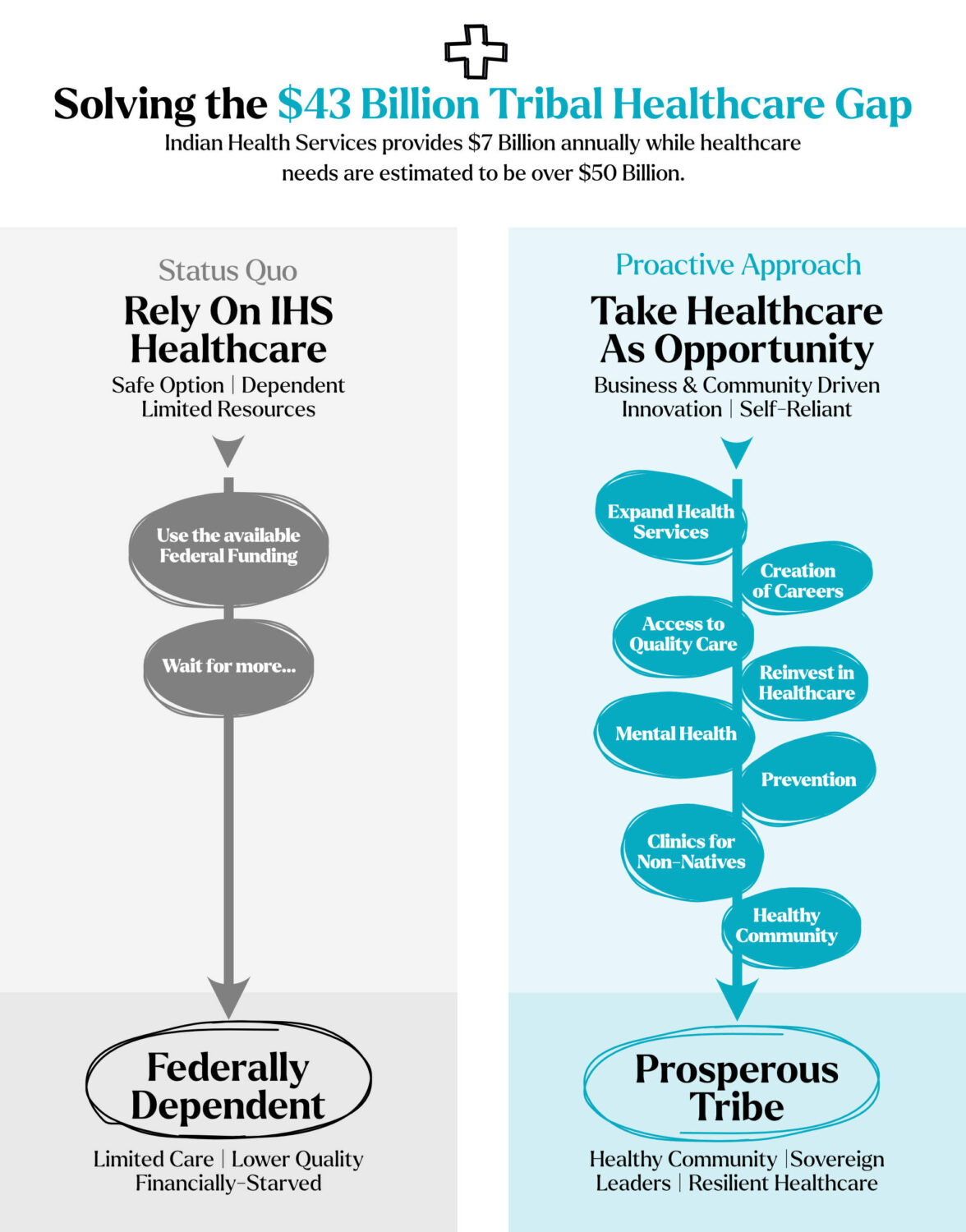
Blue Stone spoke with Jamestown Chairman, Ron Allen on his Plan for a Prosperous Healthcare System for Tribes
Ron Allen, Chairman/CEO of the Jamestown S’Klallam Tribe since 1977, has been a visionary generational steward of Indian Country in his time as a Tribal Leader. A fierce defendant of self-governance, one of Chairman Allen’s greatest contributions to his community in Jamestown has been in healthcare. His vision for a health system that operates at a premier level both regionally and for his Tribal community helped drive Jamestown’s health systems to where it is today. Ron spoke with the Blue Stone team about what the keys to Jamestown’s success has been, and what other Tribes can take away as they build both their healthcare and economic future.
The following transcript has been edited for clarity.
Blue Stone: Jamestown S’Klallam Tribal health system has become a top health system in the Olympic Peninsula region, and one of the top health systems across all of Indian Country. What is the perspective of Tribal health that you and your community take?
Ron Allen: We look at healthcare as an opportunity both for the quality of health care in our community and as a business. When I say that, I mean it’s an opportunity to find and create more professional ways to meet the gaps in services and needs of the community. Healthcare has become very complicated today in how we pay for it and capture its cost. It’s not just the facility, but the doctors, nurses, and administration. We look at how we can manage all of those services, and how we can fill gaps in the healthcare marketplace to better meet the needs of our people, from a financial standpoint.
Blue Stone: There is a bit of a mindset shift required to start managing healthcare in the way you’re discussing, rather than the way Tribes and non-Tribal organizations typically run their health systems. What do you think this involves?
Ron Allen: There are a couple key aspects of our mindset when it comes to healthcare, but first and foremost you have to run it like a business. I don’t only mean that in the sense of finances. Tribes must run their healthcare system in a very professional way and provide the highest quality of care to your people. So whether you’re trying to increase revenues or not, run it like a business.
The second is opening clinics up to non-natives. In doing so we’ve expanded our market and become more inclusive. But it has allowed us to improve the health and wellbeing of the whole region that the Tribe is a part. Opening up the clinic to the broader community has really enabled us to launch our services to the next level. Its allowed us to do four main things:
- Expand our market (non-native family members, children, workers, and general community) and generate more revenues to put back into the system
- Improve the quality of providers we are able to recruit and retain
- Expand services into specialized areas and preventative care
- Expand access to services (transport to clinic, mobile units)
Blue Stone: You mention expansion of services, what are some of the areas you’ve been able to expand in with increased revenues?
Ron Allen: First we started with the mobile unit, taking our services to Tribal citizens and the broader community that cannot travel to us. We were able to construct a specialist building for outpatient substance abuse services. It has been very successful and now we are turning to building a 16-bed crisis-inpatient facility. We are able to do this because of the additional revenues, because we’ve run it like a business.
Jamestown S’klallam Tribal Health Cinic
One of the main problems we face is substance dependency, and that happens from our Tribal citizens living in environments that cause the dependency. So our next move that we are doing is building Transitional Housing. So now our citizens do not have to go back to the environment that caused the issues in the first place. Then they can transition out of transitional housing into their own place, they have become self-reliant, enhanced their self-esteem, and restored their cultural identity as an individual.
So that is how we can look at healthcare holistically, and we only are able do that because of our revenues and the system in that way.
Blue Stone: To shift gears on you a little bit, I’d like to think about how healthcare impacts the economic system of your Tribe. What do you see as economic impacts to the Jamestown community from your expansion in the health industry.
Ron Allen: We are creating great jobs here on the reservation. Healthcare is not just the providers, but it’s the administrative and public health side too. That includes human resources, finance, and IT as well. So there’s really a wealth of quality workforce opportunities for our Tribal citizens in healthcare. For our Tribal citizens that are interested in pursuing these careers we help them get through school, and we offer them good salaries when they are finished.
Healthcare is really a holistic impact too. Public safety is an area we have seen impacted and this is a direct impact to the ability of our Tribal citizens to develop their educational, workforce, and entrepreneurial skill sets.
Blue Stone: At Blue Stone we work with a lot of Tribes that are uncertain about the idea of healthcare for-profit, or healthcare as an economic driver. Whether it’s tackling the complexity of the issue, resistance to opening the clinic to non-natives, or something else, a lot of Tribes and Tribal leaders struggle to find a path forward in this area. Do you have any thoughts you would like to share with other Tribes as they consider the future of their economies and health systems, and try to build a better future?
Ron Allen: Indian Health Services is allocated about $7 Billion annually to support the health needs of all Tribes. The actual need of Tribal Nations in healthcare is estimated to be over $50 Billion annually. So we as Tribal communities are facing a huge financial gap in the resources available to us for our healthcare and what we actually need to be healthy people.
So how do we bridge it? Do we wait for the federal government to fill it, or do we take the proactive approach? I think we have to take the proactive approach, and we have to ask ourselves what are the alternatives. When we drive additional revenues to our systems we are helping ourselves and bridging this gap. We are also helping the federal government regarding their trust obligations, and if they recognize that we’re going to continue to see favorable policies in this area.
Bottom line is, what is the alternative? If you can find another solution, great. But you have to simplify it, you have to visualize it and get to the root of the issue. That is how you get the support for it in the community for both Indian and the surrounding community.

